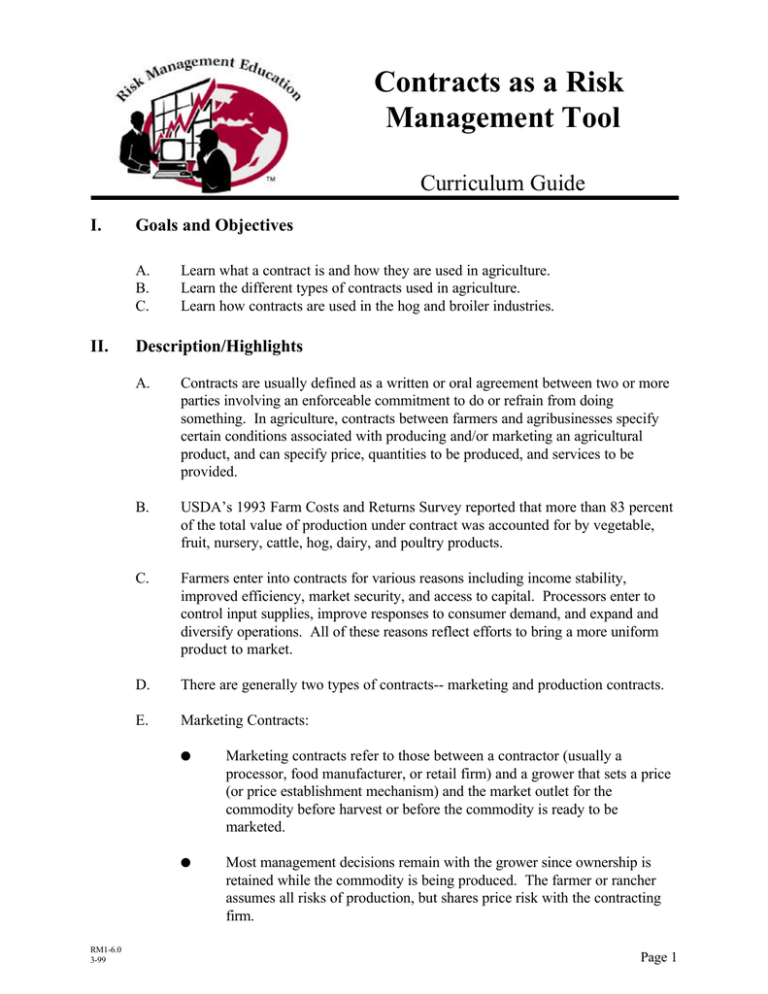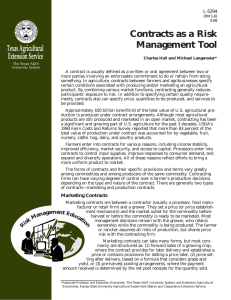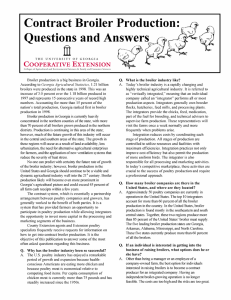Contracts as a Risk Management Tool Curriculum Guide
advertisement

Contracts as a Risk Management Tool Curriculum Guide I. Goals and Objectives A. B. C. II. RM1-6.0 3-99 Learn what a contract is and how they are used in agriculture. Learn the different types of contracts used in agriculture. Learn how contracts are used in the hog and broiler industries. Description/Highlights A. Contracts are usually defined as a written or oral agreement between two or more parties involving an enforceable commitment to do or refrain from doing something. In agriculture, contracts between farmers and agribusinesses specify certain conditions associated with producing and/or marketing an agricultural product, and can specify price, quantities to be produced, and services to be provided. B. USDA’s 1993 Farm Costs and Returns Survey reported that more than 83 percent of the total value of production under contract was accounted for by vegetable, fruit, nursery, cattle, hog, dairy, and poultry products. C. Farmers enter into contracts for various reasons including income stability, improved efficiency, market security, and access to capital. Processors enter to control input supplies, improve responses to consumer demand, and expand and diversify operations. All of these reasons reflect efforts to bring a more uniform product to market. D. There are generally two types of contracts-- marketing and production contracts. E. Marketing Contracts: Ž Marketing contracts refer to those between a contractor (usually a processor, food manufacturer, or retail firm) and a grower that sets a price (or price establishment mechanism) and the market outlet for the commodity before harvest or before the commodity is ready to be marketed. Ž Most management decisions remain with the grower since ownership is retained while the commodity is being produced. The farmer or rancher assumes all risks of production, but shares price risk with the contracting firm. Page 1 Ž F. G. RM1-6.0 3-99 Marketing contracts can take many forms, but most commonly are structured as: (1) forward sales of a growing crop where the contract provides for later delivery and establishes a price, or contains provisions for setting a price later, (2) price setting after delivery based on a formula that considers grade and yield, or (3) pre-harvest pooling arrangements where the payment amount received is determined by the net pool receipts for the quantity sold. Production Contracts: Ž Production contracts specify the quality and quantity of production inputs to be supplied by the contracting firm (processor, feed mill, or other farm operation), the quality and quantity of a particular commodity to be produced, and the type of compensation that the grower (contractee) will receive for services rendered. Ž One advantage of production contracts is that the farmer and contractor share the risks of both production and marketing of the commodity. Another advantage is that financing is more readily available because funds may be obtained either directly from the contractor or indirectly through other lenders who are more assured of loan repayment. Ž Disadvantages to production contracts become evident when contractors choose an inefficient producer. This leaves the contractor open to the possibility of losing a substantial amount of money before the problem is corrected. Also, growers may find it difficult to save enough money from the fixed payment to build their own facilities or purchase equipment. Listed below are three types of Production Contracts. 1. Market-specific production contracts are those that are negotiated between a buyer who operates at one stage of the value chain and a seller who operates at another. For example, a farmer may agree to deliver an agreed upon quantity of animals to a packer on a specific date. 2. Production-management contracts typically transfer more control and risk across stages of the value chain than market-specific contracts. Production-management contracts typically emerge when decisions at the upstream (or seller’s stage) directly affect an attribute considered valuable to the downstream (or buyer’s stage) or vice versa. 3. Resource-providing contracts can be thought of as productionmanagement contracts in which the contractor, at one stage of production, retains ownership of a key input as it is transferred to another stage. For example, a poultry processor retains ownership of the chicks as they are raised by a farmer. Page 2 H. I. III. Ž The contractor typically bears the costs associated with feed, medication, transportation in and out, feeder pigs for finishing contracts, and breeding stock for feeder pig production contracts. Growers typically raise the pigs in their own facilities, and are compensated on a fee basis. Growers costs typically include facility costs, repairs, utilities, insurance, and property taxes. Ž The two major risks involved in hog production are the risks associated with investing in specialized facilities and the risks associated with fluctuating returns. Investment risk is the largest risk that contract hog producers face. Ž Hog finishing contracts are more prevalent than contracts for feeder pig and farrow-to-finish production, or nursery production. Ž Contract payments can be on a per head basis, a per pound of gain basis, a per day basis, or a per square foot of pig space basis. Contracting in the Boiler Industry Ž Specific terms of broiler contracts vary from company to company, with most contracts specifying the provision of inputs and the compensation to farmers. Ž The farmer usually provides land and housing facilities, labor, and other operating expenses such as repairs and maintenance, manure disposal, and chicken house cleaning. The processor/contractor provides chicks, feed, veterinary supplies, management services, and transportation. Expenses for fuel and litter disposal can be shared or paid by either party, depending on the specifications of the contract. Ž Broiler contracts usually provide three types of compensation for growers: (1) the base payment, (2) an incentive or performance payment (a percentage of the difference between average settlement costs of all flocks contracted during a specific period and costs associated with an individual grower), and (3) terms for any disaster payments. Potential Speakers A. B. RM1-6.0 3-99 Swine Production Contracts Extension Economist Individuals at different levels of the supply chain that use contracts. Page 3 IV. Review Questions A. What are the two types of contracts that are generally used? Describe their differences. Answer: Marketing and production contracts. With production contracts, both production and price risk are shared by the grower and contractor. With a marketing contract, only price risk is shared. Depending on the type of production contract, the contractor (buyer) may have more control over production decisions that were once made by the grower. B. Explain how contracts are used in the swine and broiler industries. Answer: Swine and Broiler contracts are similar in that the grower typically is responsible for the costs of facilities, repairs, utilities and insurance while the contractor is responsible for the costs of feed, medication, transportation, and the pigs and broilers. Income to the grower typically includes a guaranteed or bare payment, plus or minus bonuses and penalties. V. For More Details Patricia Aust. An Institutional Analysis of Vertical Coordination Verses Vertical Integration: The Case of the U.S. Broiler Industry, Staff Paper 97-24. Michigan State University Department of Agriculture Economics. June 1997 Jim Johnson, Mitch Morehart, Janet Perry, David Banker. Farmers Use of Marketing & Production Contracts, AER-747, Economic Research Service / USDA. December 1996 Lee F. Schrader. Coordination in the United States Hog/Pork Industry, Staff Paper 98-19. Purdue University Department of Agriculture Economics. October 1998. RM1-6.0 3-99 Page 4 Contracts as a Risk Management Tool Ž What is a Contract? + A written or oral agreement between two or more parties involving an enforceable commitment to do or refrain from doing something. + In agriculture, contracts between farmers and agribusinesses specify certain conditions associated with producing and/or marketing an agricultural product, and can specify price, quantities to be produced, and services to be provided. Ž Marketing Contracts + Most management decisions remain with the grower since ownership is retained while the commodity is being produced. + The most common forms are (1) forward sales of a growing crop, (2) price setting after delivery, (3) pre-harvest pooling arrangements RM1-6.0 3-99 Page 1 Contracts as a Risk Management Tool Ž Production Contracts + Specify the quality and quantity of production inputs to be supplied by the contracting firm, the quality and quantity of a particular commodity to be produced, and the type of compensation that the grower will receive for services rendered. + Advantages include sharing risk by growers and contractors, and financing is more readily available. + Disadvantages include contractors losing money by picking inefficient producers, and producers may find it difficult to save money from fixed payments. RM1-6.0 3-99 Page 2 Contracts as a Risk Management Tool Ž Ž Three Types of Production Contracts 1. Market-Specific Production Contracts 2. Production-Management Contracts 3. Resource-Providing Contracts Swine Production Contracts + Contractors bear costs associated with feed, medication, transportation, feeder pigs, and breeding stock. + Growers raise the hogs in their own facilities and are compensated on a fee basis. + Two Major Risks: 1. Risk associated with investing in specialized facilities; and 2. Risk associated with fluctuating returns RM1-6.0 3-99 Page 3 Contracts as a Risk Management Tool Ž Contract Feeder Pig Finishing Worksheet Item a Example Your Farm A. Variable Cost Per Pig Space 1. Utilities, Fuel, and Oil 2. Hired Labor 3. Building and Equipment Repairs 4. Miscellaneous Cost 5. Total Variable Cost (1 + 2 + 3 + 4) B. Fixed Cost Per Pig Space 6. Depreciation on Buildings and Equipment 7. Interest on Buildings and Equipment 8. Insurance and Taxes on Buildings and Equipment 9. Total Fixed Cost (6 + 7 + 8) C. Total Cost Per Pig Space (5 + 9) $ 10.50 8.85 2.60 ______ ______ ______ $ 21.95 $ 27.30 ______ ______ D. Gross Return Per Pig Spacea 10. Base Payment 11. Feed Efficiency Bonus or Penalty 12. Death Loss Bonus or Penalty 13. Total Compensation Per Pig Space E. Return to Operator Labor and Management (D-C) $ 35.00 0.00 0.00 $ 35.00 $ 7.70 ______ ______ ______ ______ ______ $ 0.70 0.00 3.25 1.40 $ 5.35 Bonuses and penalties should be spread over the number of head marketed. This table outlines a worksheet that can be used to calculate the costs and returns per pig space for contract hog finishing. RM1-6.0 3-99 Page 4 Contracts as a Risk Management Tool Ž Broiler Production Contracts + Contractors/Processors provide chicks, feed, veterinary supplies, management services, and transportation. + Farmers provide land and housing facilities, labor, and other operating expenses such as repairs and maintenance, manure disposal, and chicken housing cleaning. + Broiler contracts usually provide three types of compensation for growers: 1. Base Payment 2. Incentive or Performance Payment 3. Terms for any Disaster Payment RM1-6.0 3-99 Page 5




